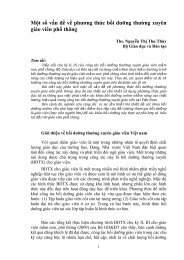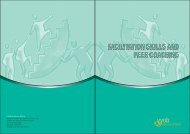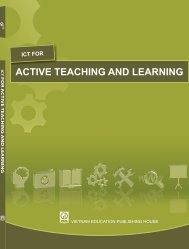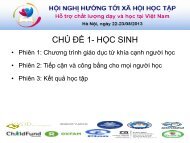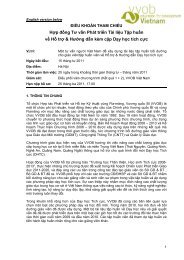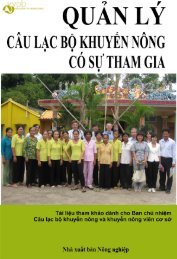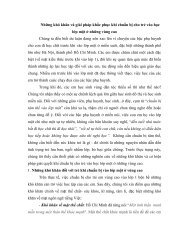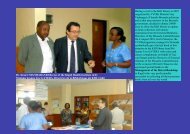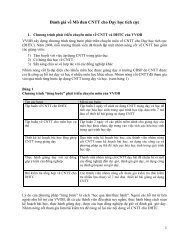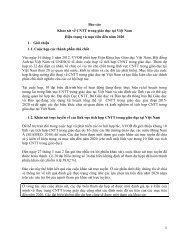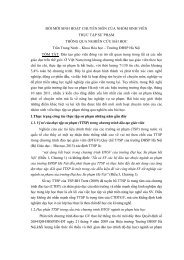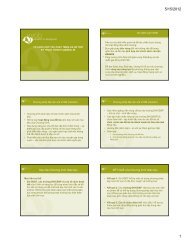Kenya Multi-Year Programme 2011-2013 - VVOB
Kenya Multi-Year Programme 2011-2013 - VVOB
Kenya Multi-Year Programme 2011-2013 - VVOB
- No tags were found...
Create successful ePaper yourself
Turn your PDF publications into a flip-book with our unique Google optimized e-Paper software.
6. Applied cooperation strategies <strong>2011</strong>-<strong>2013</strong>6.1. Development of the programme: Description of the processThe proposed programme is a continuation of the first phase of the ―MOE-<strong>VVOB</strong> collaborativeprogramme 2008-<strong>2013</strong>‖ and will retain both sub-programmes:1. Integration of ICT in teaching and learning and 2. Healthy LearningEach will contribute to achieving the objectives and targets of KESSP II (as overarching generalpurpose) linked to specific investment programmes (see Chapter 3.2.2. KESSP).Some changes are proposed to the scope of the programme, which translates in adjusted targets andoutcomes compared with the original MOE-<strong>VVOB</strong> <strong>Programme</strong> Document (signed on 8 August 2008).These adjustments are based on the results and experiences of the first phase. Changes are alsorequired because of the agreement with the funding agency (Directorate General Development) toreduce the budget of <strong>VVOB</strong> programmes in the non-partner countries in favour of the Belgian bi-lateralpartner countries and the decision of the <strong>VVOB</strong> Board to stop DGD funded programmes in <strong>Kenya</strong> in<strong>2013</strong>. This second phase will be aligned with the financial year of the <strong>Kenya</strong> Government, and it isenvisaged to run till 30 June <strong>2013</strong>.The process of developing the programme <strong>2011</strong>-<strong>2013</strong> started with the year evaluation of 2009, whenthe operational teams for both sub-programmes made reflections on the achievements and lessonslearned. The deliberations continued in 2010, during regular team meetings. Additional insights camefrom the external evaluation for the period 2008-2009, carried out in February 2010, andcommissioned by <strong>VVOB</strong> head office (see also Chapter 4.2.)In the same period, MOE and EDCG inistiated the process of developing and formulating KESSP II.<strong>VVOB</strong> staff has been involved, all along. The <strong>VVOB</strong> <strong>Programme</strong> Manager attended the KESSP JointReview Meeting (November 2009) and the KESSP Budget Review Meeting (March 2010). <strong>VVOB</strong>technical staff gave input during the development of the strategies for the relevant Investment<strong>Programme</strong>s (ICT and School Health, Nutrition and Meals), including during the KESSP IIdevelopment workshop held from 4 to 17 June 2010. As such, <strong>VVOB</strong> is fully aware of the MOEpriorities and had opportunity to discuss how the <strong>VVOB</strong> input can help MOE to achieve the KESSPtargets.6.2. Problem analysis and motivationIt is of great concern to the <strong>Kenya</strong> Government that a great number of children of school going age(primary and secondary) cannot benefit from quality education. In this, poverty is a major contributingfactor. With the introduction of Free Primary Education (in 2003) and Free Day Secondary Education(in 2008), part of this problem has been addressed. But, still, an estimated 500.000 children (or more)are still staying away from school to look after sick parents, to herd cattle ... or they are sent into thestreets to beg. There are also quite a number of aids orphans. On the ―supply side‖, there are alsoshortfalls: not enough schools and class rooms (especially at secondary level. Many schools are notmaintained, or do not have the right facilities (e.g. toilets), or do not have the needed learningmaterials. Due to a teacher shortage, several schools still have big class groups (up to 80 pupils, isnot uncommon).The Government puts in extra efforts to support the meet increased demands and continues allocatethe highest part of the annual budget to the Education sector. Special attention goes to the poorthrough school meals, increased budgets for bursaries etc. Various Economic Stimulus Packages(since 2009) also benefit education. But, expansion of the school going population adds pressure onservices that are not yet optimal.Although the weaknesses and impediments for improved quality of education are known andrecognized, the education ministries have insufficient reliable tools to describe the problems and the<strong>Kenya</strong> - <strong>Multi</strong>-<strong>Year</strong> <strong>Programme</strong> <strong>2011</strong>-<strong>2013</strong> 28/148



